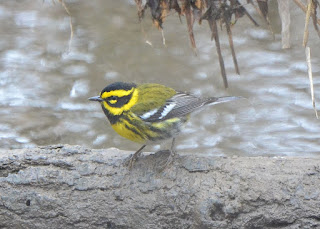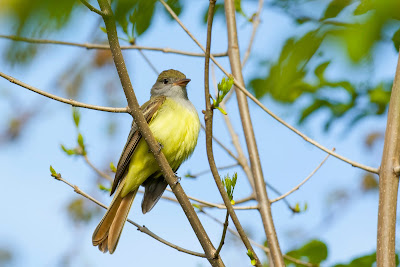 |
| First in Illinois: This great kiskadee attracted birders from throughout the Midwest to Will County earlier this month. Photo by Matt Misewicz. |
(published 12-17-20)
 |
| The scene along Front Street in Channahon as dozens of birders wait for a glimpse of the great kiskadee. Photo by Ryan Jones. |
The “Miracle on Front Street” brought the curtain down on a birding
year full of surprises. Well, not quite. A week later, in almost the same spot,
a western tanager turned up, reported by Niklas Klauss. It was Channahon’s
third rarity in three weeks, a hot streak that began with a Eurasian wigeon in
late November. You guessed it: The fancy duck was right about where the
kiskadee, and later the tanager, would soon appear.
 |
One week after the kiskadee's arrival, birders rushed back to Channahon to see this dazzling western tanager. Photo by Matt Misewicz. |
Joining the kiskadee as worthy Bird of the Year candidates were a Townsend’s warbler at Deer Grove Forest Preserve in Cook County (found in April by Heidi Tarasiuk); black-headed grosbeak in Woodstock (Oct.); and a golden-crowned sparrow in the Rockford backyard of Dan and Barbara Williams (Nov.). A front porch rufous hummingbird hosted by the Baier family in Lisle was yet another December treat.
Sightings of these rare birds, combined with flexible work schedules and low gas prices, created a perfect storm for bird chasers. In 2020, homebound enthusiasts needed few excuses to hit the highway.
Indeed, the pandemic changed how we bird. We wore face
coverings, did less carpooling and tried our best to social distance on the trails.
Perhaps the biggest change brought about by the virus was
more birders, especially backyard watchers. Many came to realize that feeding
birds is a pleasant diversion. Keeping a yard list became a thing—a fun
challenge for all ages and a solid remote learning activity.
 |
| An evening grosbeak could visit your house this winter, too! They usually travel in flocks. Photo by Josh Engel/Red Hill Birding. |
Fall proved especially rich. In late October, reports of
evening grosbeaks poured in throughout the region—almost unheard of in these
parts. Just the thought of one landing on my sunflower feeder is exciting, and currently
it’s a real possibility!
Other “winter finches” have invaded as well, namely common
redpoll, pine siskin, red crossbill and white-winged crossbill. Red-breasted
nuthatch is back, too. All are nomadic species from the north that don’t come
around every year. This will be an entertaining winter.
County highlights
Space limitations force me to pick and choose, but a county-by-county
listing of notable bird sightings shows the remarkable avian diversity that Chicagoland
birders encountered in 2020.
 |
| Two rufous hummingbirds—one in Lisle and this one in Naperville—thrilled DuPage birders in early December. Photo by Matt Misewicz. |
Kane: American avocet; black-necked stilt; black
scoter; black tern; Connecticut, Kirtland’s and prairie warblers; Eurasian tree
sparrow; Hudsonian godwit; northern goshawk; red-necked
phalarope; ruddy turnstone; Say’s phoebe; western kingbird; whip-poor-will
Cook: black-legged kittiwake; buff-breasted
sandpiper; Cassin’s sparrow; Franklin’s gull; great-tailed grackle; harlequin
duck; Harris’s sparrow; hoary redpoll; lark bunting; little gull; painted
bunting; parasitic jaeger; piping plover (Monty and Rose returned to Montrose
Beach, fledging three chicks!); purple gallinule; red knot; red-necked grebe;
red-throated loon; Sabine’s gull; Say’s phoebe; snowy egret; snowy owl; Swainson’s
hawk; Townsend’s warbler; varied thrush; western grebe; whimbrel;
whip-poor-will; white-faced ibis
 |
| In October, a generous homeowner in Woodstock permitted birders to view this black-headed grosbeak, a rare visitor from the West. Photo by Matt Misewicz. |
Will: black-bellied whistling duck; black-necked stilt; cattle egret; Eurasian wigeon; great kiskadee; Hudsonian godwit; western tanager; yellow-crowned night heron
McHenry: black-headed grosbeak; black tern; common
gallinule; lark sparrow; red-necked phalarope
Finally, a shout-out to Kendall County, which produced a
Townsend’s solitaire last January at Silver Springs State Park, the first
rarity of 2020. Doesn’t that seem like five years ago?
When luck and skill collide
Congratulations to Isoo O’Brien for shattering the Big Year
record for Cook County of 281 species. He did it with a common redpoll on
October 30. The Evanston high school senior likens birding to a treasure hunt,
and I couldn’t agree more.
 |
| Hundreds of birders with spring fever pursued this Townsend's warbler in a Cook County forest preserve. Photo by Scott Latimer. |
The all-time Illinois Big Year record of 334 species also fell, but at press time it was unknown what the new record would be, and who would set it. Nathan Goldberg had 340 species with Steve Huggins just one bird behind. Their lists were identical except for the Geneva Kirtland’s warbler in May; Nathan got it, Steve did not.
Springbrook Prairie steward Joe Suchecki witnessed the first
successful sandhill crane nesting at the Naperville preserve. He also
registered species No. 240 at Springbrook when a flock of 22 evening grosbeaks
flew over on November 6. Joe said he hadn’t seen evening grosbeaks in Illinois
since 1996.
Illinois Ornithological Society made the most of a
stay-at-home spring by holding a Backyard Big Day competition in April. Some
200 households from 34 counties participated. IOS followed up with a Big Sit
tournament in September that raised $5,000 for bird-related causes.
Illinois Audubon Society purchased 40 acres within the
Prairie Ridge State Natural Area in Jasper County, protecting additional
habitat for greater prairie-chickens.
The 2020 Indiana Dunes Birding Festival was cancelled but still
won the Mindful Birding Award for its devotion to ethical birding and bird
conservation. The 2021 fest is on for May 13-16.
 |
| Birders had several opportunities in 2020 to witness Hudsonian godwit, a rare shorebird. This one visited a small roadside "fluddle" in Will County, in late May. Photo by Pat Andersen. |
Black birders matter
Rocky the owl made us smile. Another New Yorker made us cringe. You surely heard about the ugly incident in Central Park last May, when a white dogwalker confronted Black birdwatcher Christian Cooper, falsely accusing him of threatening violence. A video of the encounter attracted 30 million views.
It wasn’t about birding, of course, but it did create high-profile exposure for the hobby. Black Birders Week took flight in June, a first-time awareness campaign to encourage birding by people of color.
Worth mentioning, too, is the “Bird Names for Birds”
movement. The idea, now gaining momentum, is to assign new names to birds currently
named after people. Some of the individuals, history shows, were racist in
their actions and beliefs. Some were slave owners. In August, McCown’s longspur
was officially reclassified as thick-billed longspur. Expect more such changes.
About 150 North American birds are named for people.
Checking my notes
Spotting a backyard “wormie” is hard to top, but finally getting
my lifer Kentucky warbler was my best birding moment. A big assist goes to Joan
Campbell for helping me find it at Greene Valley, where dozens of other birders
enjoyed it, too. Kentucky’s are not usually so cooperative! I guess it was just
my turn.
Best new beer? Piping Plover Pale Ale, of course, launched
by Imperial Oak Brewing (Willow Springs) in August. I’m raising one now, in a
toast. Here’s to 2020, a difficult year made better by exciting birds and fun
birding adventures. And to a brighter year ahead. Maybe I’ll see you in
Channahon.
Copyright 2020 by Jeff Reiter. All rights reserved.
























